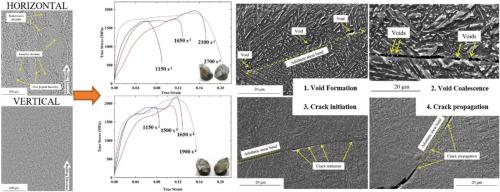Materials Science and Engineering: A ( IF 6.1 ) Pub Date : 2020-07-04 , DOI: 10.1016/j.msea.2020.139794 R. Alaghmandfard , C. Dharmendra , A.G. Odeshi , M. Mohammadi

|
This study presents an investigation on the effects of building direction on microstructure, dynamic mechanical properties, and deformation mechanisms of electron beam melted Ti-6Al-4V (EBM-Ti64) cylindrical rods. Microstructural features were characterized using optical microscopy (OM) and scanning electron microscopy (SEM). The initial microstructure in both directions consists of transformed α+β phases and grain boundary-α (along prior β-grain boundaries. The vertically built cylindrical specimens have a finer grain structure, including lower interlamellar spacing and finer α-laths compared to the horizontally built ones. Dynamic impact tests using Split-Hopkinson Pressure Bar (SHPB) were conducted on both horizontally and vertically built samples at strain rates ranging between 1150 and 2700 s−1. Dynamic mechanical properties are strain-rate sensitive; the maximum flow stress of 1960 MPa (at 2100 s−1) and 2160 MPa (1650 s−1) were obtained for horizontal and vertical specimens, respectively. Horizontal specimens fragmented when deformed at 2700 s−1, whereas the vertical specimens failed at a much lower strain rate (1900 s−1). At a given strain rate, vertical specimens exhibited better dynamic strength and lower strain (total strain) due to their finer microstructure. The temperature rise during deformation primarily governs flow softening at all conditions, which led to the formation of adiabatic shear bands (ASBs). Microstructures of deformed specimens revealed thermal softening features such as voids formation. These voids coalesced and grew, leading to crack initiation and propagation along ASBs. Fractographic examination of the fragmented specimens under impact loading revealed ductile dimples and smoother surfaces, which indicate a combination of both ductile and brittle fracture. The contribution of twinning and pyramidal <c+a> slip systems is the primary deformation mechanism during high strain rate impact loading of EBM-Ti64. The experimentally obtained flow curves are in good agreement with the Chang-Asaro equation-based constitutive modeling results.
中文翻译:

高应变速率冲击载荷下电子束熔炼Ti-6Al-4V的动态力学性能和破坏特性
本研究提出了构建方向对电子束熔化的Ti-6Al-4V(EBM-Ti64)圆柱棒的微观结构,动态力学性能和变形机理的影响的研究。使用光学显微镜(OM)和扫描电子显微镜(SEM)表征微结构特征。在两个方向上的初始微观结构均由相变的α+β相和晶界-α(沿先前的β晶界。与水平构建的圆柱试样相比,垂直构建的圆柱试样具有更细的晶粒结构,包括更低的层间间距和更细的α-板条。在水平和垂直方向上构建的样本上,使用Split-Hopkinson压力棒(SHPB)进行的动态冲击测试的应变速率范围为1150到2700 s -1。动态力学性能对应变率敏感;水平和垂直试样的最大流应力分别为1960 MPa(在2100 s -1)和2160 MPa(1650 s -1)。水平试样在2700 s -1变形时会破碎,而垂直试样在低得多的应变率(1900 s -1)下会破裂)。在给定的应变速率下,垂直试样由于具有更好的微观结构,因此具有更好的动态强度和更低的应变(总应变)。变形过程中的温度上升主要决定着在所有条件下的流动软化,这导致了绝热剪切带(ASBs)的形成。变形试样的微观结构显示出热软化特征,例如形成空隙。这些空隙合并并增长,导致裂纹萌生并沿ASB扩展。碎片在冲击载荷下的分形检查显示出韧性凹痕和光滑表面,表明韧性断裂和脆性断裂的结合。孪晶和金字塔形<c + a>滑移系统的贡献是EBM-Ti64在高应变率冲击载荷下的主要变形机制。











































 京公网安备 11010802027423号
京公网安备 11010802027423号